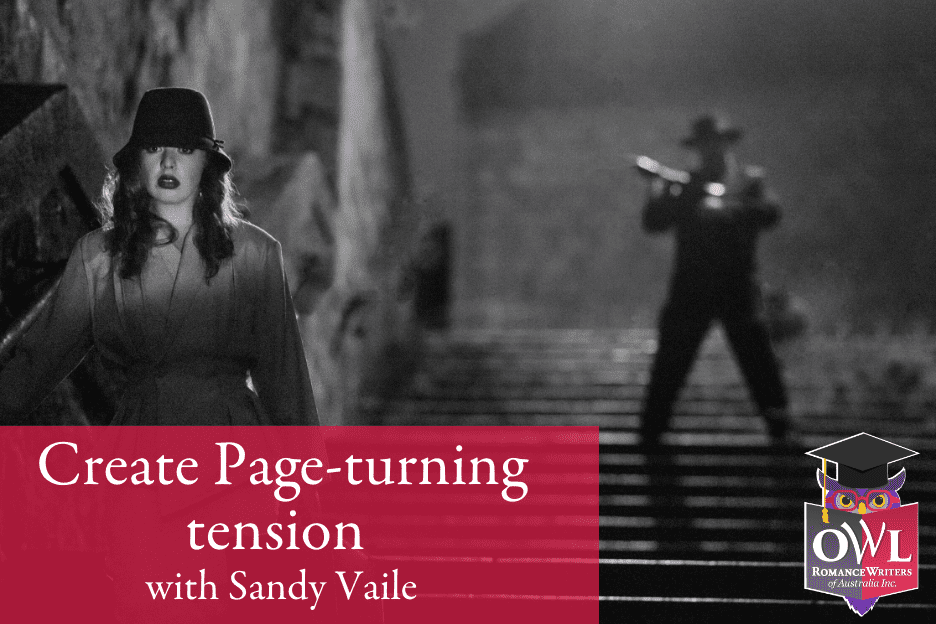The Importance of matching suspense to the fluctuations of plot
Tension is a critical element of all stories and needs to be maintained in order to keep readers turning the pages, but how does this correspond to the fluctuations of plot? There can’t be life-threatening situations in every chapter, nor are all stories about mortal danger. So, let’s explore how you can match the fluctuations in a story’s plot to the level of tension.
What Is Tension?
“Tension is the emotional strain we feel in the face of uncertainty.” Sandy Vaile
In fiction we focus on unpleasant events. To create tension we develop characters our readers care about (or are at least interested in), give them something important to lose and then put all sorts of obstacles in their way to make the outcome of their journey uncertain.
All of this makes the reader worry.
What are fluctuations of plot?
Over a whole story there is a pattern of rising tension that culminates in a crisis and then falling tension as the characters consider their next move and gather resources. This pattern is repeated over and over again. Tension runs through eveery facet of your story, from internal and external conflict to unresolved questions and an uncertain outcome.
If there is no tension at all, the story has either concluded or the reader has dozed off.
Blatant Tension
Increase tension during times of turmoil, like mortal danger, a life upheaval or imminent threat to something the character cares about. When you reach key moments in your story, tension should be high with the reader desperate to know what happens next and truly worried for the character’s happiness or safety.
In order to do this, we can use techniques like shocking revelations, increased stakes, a sense of urgency or forcing the protagonist to face something they dread.
Here are some examples of blatant tension:
- A woman in remote countryside alone, whose horse bucks her off, breaking her leg.
- A policeman enters a dark warehouse that an armed robber just ran into.
- A howling cyclone bears down on a woman and her child as they huddle behind the only solid structure for miles, a metal power box.
- A couple enjoying an ice-cream by the beach when a woman marches up to them and screams that she is his wife.
Subtle Tension
Decrease tension when your characters need time to reflect on what just happened, solve a conundrum or gather themselves for the next onslaught. These moments allow the reader to breathe a little and fall in love with your characters. They happen in between crises and are particularly important in romance stories because readers expect to spend time exploring the character’s emotions and inner turmoil.
But even when you decrease the level of tension, the uncertainty about the outcome of the whole situation doesn’t completely ease. To achieve subtle tension we use techniques like raising questions, planting hooks, changing expectations, hinting at a character’s fears or secrets and foreshadowing the turmoil to come.
Here are some examples of subtle tension:
- A woman tries to distract her husband from searching through old files, knowing her first marriage certificate is in there and he has no idea she was married before.
- The owner of a failing business ducks into a coffee shop to avoid the bank manager who has been phoning twice a day.
- After Dave storms out of Tina’s appartment, annoyed that she’d double-booked their dinner date, she has trouble focusing on the contract her boss insisted she review tonight. All she can think about is how wonderful spending time with Dave has been and how well-matched they are, but work has to take first priority at the moment. She hopes he will forgive her.
- The protagonist breathes a sigh of relief after finding her best friend’s house key, but can’t escape the nagging suspicion that the man who returned it might have made a copy.
Think of tension like the surge and retreat of waves at the beach. It builds to a crest, crashes dramatically and then quietly fades back into the ocean, over and over again. Match each wave with key moments in your story plot so you can control the increase and decrease of anxiety your reader experiences, but never let it completely disappear.
Join me in the Create Page-Turning Tension course, starting on 6th July 2020, to dive into the heart-racing depths of tension creation, so you can hook your readers and keep them gripped all the way to the end.

CREATE PAGE-TURNING TENSION WITH SANDY VAILE
Booking Link: https://www.trybooking.com/BHGIS
Have you been told your character isn’t engaging or that special something is missing from your story?
The Create Page-Turning Tension workshop is for fiction writers who want to hook readers and compel them to keep turning pages all the way to the end.
Uncertainty is the ultimate weapon against readers abandoning your story, because it exploits their innate curiosity. Learn what readers need from you to fully commit to a story, so you can squeeze every bit of emotional angst from your characters.
You’ll be writing angst-ridden tension in no time!
This workshop will give you the skills to:
- Know how to build tension to enhance conflict, pace and character development.
- When to release information for the maximum effect.
- Develop hooks, from killer openings to cliff-hanger endings.
- Appreciate the role of emotions in creating tension.
- Identify opportunities to increase uncertainty.
What people are saying about Sandy’s workshops:
“Helpful, practical and inspirational, Sandy’s workshop took my writing to the next level.”
“I loved Sandy’s dedication to giving the best feedback possible. It’s made a huge difference to me already.”
“The workshop was well structured, with information provided at an appropriate pace to enable participants to absorb it and apply it to their own work.”
“I liked the friendly nature of the learning experience.”
Pre-course preparation
This workshop is suited to aspiring writers, assuming basic English skills.
Course Type
Craft.
Hours of Commitment
1-2 hours per week, plus chats.
About Sandy Vaile

Sandy Vaile is a motorbike-riding daredevil who isn’t content with a story unless there’s a courageous heroine and a dead body. Her dream is to empower fiction writers across the globe to thrive and reach their full potential, by providing education and personalised guidance.
Sandy is an experienced course presenter with a decade of experience in the fiction writing industry. She prides herself on providing a nurturing learning environment that enables participants to truly absorb the material and apply it to their own work.
In her spare time, Sandy composes procedures for high-risk industrial processes, judges competitions, runs The Fearless Novelist Facebook group, and offers coaching and critiquing services.
Don’t miss out on future blogs and writing resources from Sandy Vaile, subscribe here.
Also connect with Sandy Vaile on Facebook, Twitter, Instagram and YouTube.

